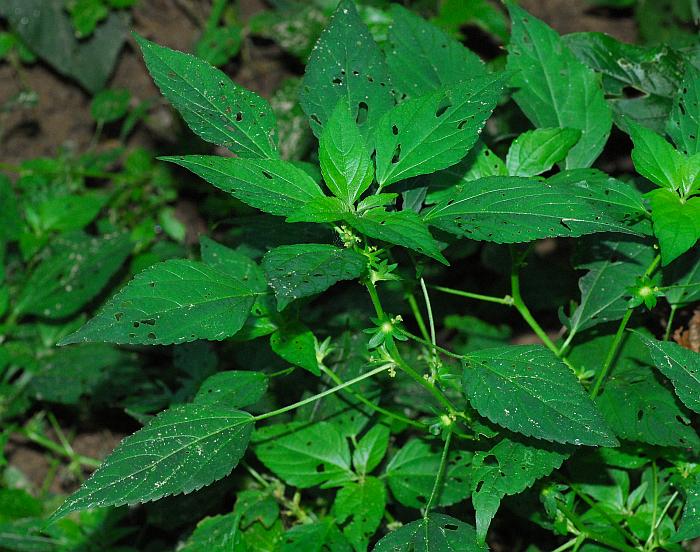Acalypha deamii (Weath.) H.E. Ahles
Two-Seeded Mercury

Native
CC = 7
CW = 3
MOC = 9
SRank = S1
© SRTurner
Acalypha deamii (Weath.) H.E. AhlesTwo-Seeded Mercury | |
 |
Native CC = 7 CW = 3 MOC = 9 SRank = S1 |
© SRTurner |
|
Family - Euphorbiaceae Habit - Taprooted, monoecious, annual forb. Stem - Erect, to 60 cm, glabrous or pubescent with curled hairs. Sap clear.
Leaf - Leaves alternate, long-petiolate with petiole approximately equalling blade in length. Blades 1-12 cm long, ovate to broadly rhombic, mostly broadly angled at the base, tapered to a sharply pointed tip, bluntly toothed, the surfaces sparsely to moderately pubescent.
Inflorescence - Inflorescences axillary spikes, 1-3 per node, each with 1-3 basal pistillate flowers below few to several nodes of staminate flower clusters.
Pistillate flowers - Bracts subtending pistillate flowers 8-25 mm long, appearing more or less folded longitudinally, with 7-9 linear to lanceolate lobes, the margins sparsely to moderately hairy, the outer surface glabrous or sparsely hairy, sometimes some of the hairs gland-tipped.
Fruit - Fruits 2.5-3.4 mm long, 2-locular, 2-seeded, the surface moderately to densely hairy, lacking tubercles or slender projections at maturity. Seeds 2.2-3.2 mm long.
Flowering - July - October. Habitat - Streambanks, bottomland forests. Origin - Native to the U.S. Lookalikes - A. rhomboidea, Boehmeria cylindrica (vegetatively). Other info. - This species is uncommon and sporadic, and as of 2018 was listed by the state of Missouri as S1 (critically imperiled). Like A. rhomboidea, it is generally unremarkable in appearance except for the distinguishing feature of very long petioles. It is differentiated from that species by having 2-locular, 2-seeded fruits. Care should be exercised in this determination, since fruits of A. rhomboidea, which are normally 3-seeded, can occasionally abort one locule. Multiple fruits should therefore be examined. The fruits and seeds are also nearly twice the size of those of A. rhomboidea, and with practice this difference can be discerned in the field. Photographs taken near Sherman Beach, St. Louis County, MO, 8-7-2012 (SRTurner). |